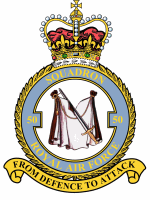
No. 100 Group was a special duties group within RAF Bomber Command. The group was formed on 11 November 1943 to consolidate the increasingly complex business of electronic warfare and countermeasures in one organisation. The group was responsible for the development, operational trial and use of electronic warfare and countermeasures equipment. It was based at RAF stations in East Anglia, chiefly Norfolk.
No. 515 Squadron RAF was a squadron of the Royal Air Force formed during the Second World War. It ushered in Electronic countermeasures (ECM) warfare, jamming enemy radar installations from October 1942 as the only such squadron in the RAF initially. Later in the war 515 Sqn was joined by other squadrons as part of No. 100 Group RAF. The squadron disbanded after VE day, when the need for such a specialised squadron had reduced.

No. 214 Squadron is a former unit of the Royal Air Force.
No. 462 Squadron is a Royal Australian Air Force (RAAF) squadron which forms part of the Information Warfare Directorate in the RAAF's Air Warfare Centre. The squadron was first formed in 1942 as a heavy bomber unit and saw combat in this role in the Mediterranean area until it was disbanded in March 1944. It was reformed in the United Kingdom in August 1944 to participate in the bombing campaign against Germany, and in December that year converted to a specialist electronic warfare unit. No. 462 Squadron continued in this role until the end of the European war in May 1945 and was disbanded in September that year. The squadron was reformed in its current role during April 2005.

No. 192 Squadron was a Royal Air Force squadron operational during the First World War as a night training squadron and during the Second World War as a radar countermeasure unit. After the war the squadron served again in the Electronic Intelligence role, until disbanded in 1958.
No. 158 Squadron RAF was a World War I proposed ground attack squadron that did not became operational in time to see action, and a World War II bomber squadron. After World War II had ended in Europe the squadron operated in the transport role until disbandment in December 1945.
No. 77 Squadron RAF was a squadron of the Royal Air Force which was active in various incarnations between 1916 and 1963.
No 297 Squadron was a squadron of the Royal Air Force. It was notable for being the first airborne forces squadron formed. With sister No 296 Squadron it formed No 38 Wing RAF in January 1942, joined in August by No 295 Squadron; the Wing expanded in 1943 to become No 38 Group RAF. The squadron saw action in Sicily and took part in the D-Day invasion and Operation Market Garden. It was disbanded in 1950.
Number 76 Squadron was a squadron of the Royal Air Force. It was formed during World War I as a home defence fighter squadron and in its second incarnation during World War II flew as a bomber squadron, first as an operational training unit and later as an active bomber squadron. With the end of the war the squadron converted to the role of transport squadron, to be reactivated shortly in the bomber role during the 1950s. From 2007 to 2011, it was a training unit, equipped with the Short Tucano at RAF Linton-on-Ouse.
No. 199 Squadron was a Royal Air Force aircraft squadron that operated during the Second World War and later in the 1950s as a radar countermeasures squadron.

RAF 258 Squadron was a Royal Air Force squadron during World War I and World War II.
No. 108 Squadron RAF was originally a squadron of the Royal Flying Corps during World War I which continued to serve with the Royal Air Force in World War II.
No. 109 Squadron RAF was an aircraft squadron of the Royal Air Force.
No. 139 (Jamaica) Squadron RAF was a Royal Air Force Squadron that was fighter unit in World War I and a bomber unit from World War II until the 1960s.
No. 163 Squadron RAF was a Royal Air Force Squadron that was a communications and light bomber unit in World War II.
No. 162 Squadron RAF was a Royal Air Force Squadron that was a radio jamming/calibration and light bomber unit in World War II.
No. 173 Squadron RAF was a Royal Air Force Squadron that was a communications unit in World War II.
No. 174 (Mauritius) Squadron RAF was a Royal Air Force Squadron that was a fighter-bomber unit in World War II.

No. 50 Squadron was a squadron of the Royal Air Force. It was formed during the First World War as a home defence fighter squadron, and operated as a bomber squadron during the Second World War and the Cold War. It disbanded for the last time in 1984.
No. 80 Wing RAF was a unit of the Royal Air Force (RAF) during both World Wars and briefly in the 1950s. In the last months of World War I it controlled RAF and Australian Flying Corps fighter squadrons. It was reformed in 1940 to operate electronic countermeasures in the Battle of the Beams.





